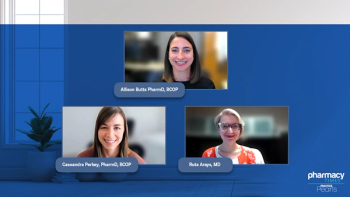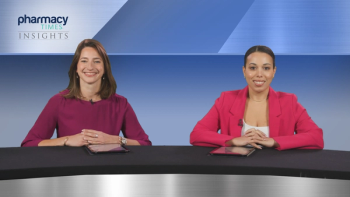
Advances in Early Breast Cancer: NATALEE Trial Overview
Dr Moore examines findings from the NATALEE trial.
Heather Moore, CPP, PharmD: The [phase 3] NATALEE trial [NCT03701334] investigated the use of ribociclib in combination with endocrine therapy to determine if this improved outcomes, specifically looking at early-stage breast cancer. They evaluated ribociclib plus endocrine therapy in stage 2 or stage 3 hormone receptor-positive, HER2-negative [HR+/HER2-] early-stage breast cancer, specifically for patients who are at a higher risk for recurrence. Of note, they did include patients who were node-negative, and what was presented was actually an interim analysis and they were specifically focusing on disease-free survival, and that was their prespecified end point.
With ribociclib, the dosing is different than what is seen in the MONALEESA study [NCT01958021]. They did elect to use a lower dose, mostly for toxicity tolerability. Ribociclib at 400 mg was given for 3 weeks on and 1 week off. This was given for a total of 3 years in combination with endocrine therapy. They included both pre- and postmenopausal women. Of note, they did include men. We don’t typically see that within most of our clinical trials. They were randomized 1:1, either to the ribociclib plus endocrine therapy—of note, aromatase inhibition included letrozole or anastrozole; they did not allow for steroidal exemestane—vs endocrine therapy alone. For patients who were either male or for women who were premenopausal, they did also receive goserelin. For patients to be included, they had to be stage 2A. For N-zero, they did have to have an additional risk factor. If they had 1 to 3 axillary lymph nodes, then they were considered to be N1, or participants could be stage 2B or stage 3. This is a little bit different from what we’ve seen with abemaciclib in the adjuvant setting. They did allow for the inclusion of patients who had node-negative disease. Additionally, they did allow prior endocrine therapy if it was initiated within 12 months prior to randomization. Again, when they looked at their prespecified interim analysis of invasive disease-free survival, this was planned after 425 events.
Results that we saw from NATALEE, they were exciting. It was a median follow-up of roughly 34 months. They had a little over 5000 patients who were in the patient population, so 5101 patients. However, I do want to mention that only 20% of these patients had actually completed the 3-year course at that time. A little over half of them, 56.8% of patients, were at 2 years, but roughly 75% of those patients still remained on study. Breaking down the patient population that was included, 60% of those patients were stage 3. Twenty-one percent of those patients were stage 2B, and then 19% of those patients were stage 2A. Forty-one percent of those patients had nodal involvement with N1 disease, and then roughly 19% of those patients had N2 or N3 disease. Only 27% of patients had N-zero disease. This is important when we think about comparing it [with] abemaciclib in the adjuvant setting and their inclusion criteria. Of note, 88% of these patients had received prior neoadjuvant or adjuvant chemotherapy. When breaking down into the results of their primary end point, which was the invasive disease-free survival, ribociclib plus endocrine therapy, looking at invasive disease-free survival, 90.4% for the ribociclib arm, compared to 87.1% of patients who were in the endocrine therapy–alone arm. This was an absolute benefit of 3.3%, and this benefit was consistent across subgroups. That’s something that’s important to know when we’re thinking about the different patient groups that were included. This was regardless of stage or if they had previously received chemotherapy.
In looking at the NATALEE data, it did trend toward an improved overall survival, but we don’t have that data yet. Median follow-up is roughly 30.4 months, with an additional overall survival follow-up being planned. We’ll also be looking at the recurrence-free survival as well as the distant disease-free survival, and that hasn’t been reported out as of yet. Looking at the absolute distant disease-free survival benefit with ribociclib, this was roughly 2.2%, so 90.8% for patients who were on ribociclib vs 88.6% for patients who were on the endocrine therapy monotherapy arm. Looking at safety, I did mention earlier that we did do a dose reduction started at 400 [mg of ribociclib] in the NATALEE study vs the 600 [mg], which is standard in the MONALEESA studies, and that was to help from a tolerance and toxicity standpoint.
From a safety perspective, what was seen within NATALEE was that the 400-mg dose [of ribociclib] was safe and well tolerated. This was improved compared [with] the 600-mg dose that we’ve seen within the other MONALEESA studies in the metastatic or advanced setting. Despite doing a dose reduction down to 4 mg for initiation for the NATALEE study, however, roughly 43.8% of patients experienced a grade 3 or grade 4 neutropenia. That’s worth mentioning, especially with the start of a lower dose. Liver-related adverse effects, thinking about transaminitis or hepatotoxicity, was seen in 8.3% of patients, and this was again grade 3 or grade 4. From what we’ve seen in the MONALEESA studies, that led to QTc monitoring, thinking about QTc prolongation. So, 5.2% QT-prolonging events, and this was all grade, only 1% of those being grade 3 or grade 4. As a class effect, with CDK4/6 inhibitors, we do have to be mindful of pneumonitis. There weren’t any grade 3 or grade 4 events. However, there were roughly 1.5% of patients who had an all-grade pneumonitis event. Adverse effects that led to discontinuation, some of those were liver-related, [with] roughly 9% of patients discontinuing secondary to hepatotoxicity.
My personal takeaway from the NATALEE data is that currently the data are too immature to implement into practice quite yet. Seeing that there are more data anticipated to be presented at the San Antonio Breast Cancer Symposium at the end of this year, I think that the data that we have are exciting, but we’ll really need to think about where we’re going to use them. Abemaciclib is currently approved in the adjuvant setting for patients who have high-risk disease, meaning that they either have 4 or more positive lymph nodes, or patients who have 1 to 3 positive lymph nodes and either have another high-risk factor to include: a tumor size greater than 5 cm, a Ki-67 [marker] greater than or equal to 20 centimeters, or grade 3 disease. We really need to think about which patient population we’re going to implement this in. It’s going to make the most sense for patients who are node-negative who otherwise wouldn’t have met criteria for them abemaciclib, or maybe patients who had positive lymph node involvement but didn’t have one of those additional risk factors. I look forward to what we’ll see later in the year.
Transcript is AI-generated and edited for clarity and readability.
Newsletter
Stay informed on drug updates, treatment guidelines, and pharmacy practice trends—subscribe to Pharmacy Times for weekly clinical insights.








































































































































































































